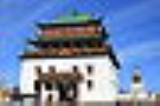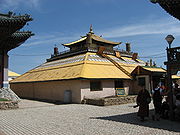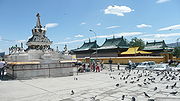
Gandantegchinlen Khiid Monastery
Encyclopedia


Monastery
Monastery denotes the building, or complex of buildings, that houses a room reserved for prayer as well as the domestic quarters and workplace of monastics, whether monks or nuns, and whether living in community or alone .Monasteries may vary greatly in size – a small dwelling accommodating only...
in the Mongolia
Mongolia
Mongolia is a landlocked country in East and Central Asia. It is bordered by Russia to the north and China to the south, east and west. Although Mongolia does not share a border with Kazakhstan, its western-most point is only from Kazakhstan's eastern tip. Ulan Bator, the capital and largest...
n capital of Ulaanbaatar
Ulaanbaatar
Ulan Bator or Ulaanbaatar is the capital and largest city of Mongolia. An independent municipality, the city is not part of any province, and its population as of 2008 is over one million....
that has been restored and revitalized since 1990. The Tibetan name translates to the "Great Place of Complete Joy." It currently has over 150 monks in residence. It features a 26.5-meter-high statue of Migjid Janraisig, a Buddhist bodhisattva
Bodhisattva
In Buddhism, a bodhisattva is either an enlightened existence or an enlightenment-being or, given the variant Sanskrit spelling satva rather than sattva, "heroic-minded one for enlightenment ." The Pali term has sometimes been translated as "wisdom-being," although in modern publications, and...
also known as Avalokitesvara
Avalokitesvara
Avalokiteśvara is a bodhisattva who embodies the compassion of all Buddhas. He is one of the more widely revered bodhisattvas in mainstream Mahayana Buddhism....
. It came under state protection in 1994.
History
The monastery was established in 1835 by the Fifth JebtsundambaJebtsundamba
The Khalkha Jebtsundamba Khutuktus were the spiritual heads of the Gelug lineage of Tibetan Buddhism in Mongolia. They also held the title of Bogd Gegeen, making them the top-ranked lamas in Mongolia.- History :...
, then Mongolia
Mongolia
Mongolia is a landlocked country in East and Central Asia. It is bordered by Russia to the north and China to the south, east and west. Although Mongolia does not share a border with Kazakhstan, its western-most point is only from Kazakhstan's eastern tip. Ulan Bator, the capital and largest...
's highest reincarnated lama
Lama
Lama is a title for a Tibetan teacher of the Dharma. The name is similar to the Sanskrit term guru .Historically, the term was used for venerated spiritual masters or heads of monasteries...
. It became the principal center of Buddhist learning in Mongolia.
In the 1930s, the Communist
Communism
Communism is a social, political and economic ideology that aims at the establishment of a classless, moneyless, revolutionary and stateless socialist society structured upon common ownership of the means of production...
government of Mongolia, under the leadership of Khorloogiin Choibalsan and under the influence of Joseph Stalin
Joseph Stalin
Joseph Vissarionovich Stalin was the Premier of the Soviet Union from 6 May 1941 to 5 March 1953. He was among the Bolshevik revolutionaries who brought about the October Revolution and had held the position of first General Secretary of the Communist Party of the Soviet Union's Central Committee...
, destroyed
Stalinist purges in Mongolia
The Stalinist repressions in Mongolia had their climax between 1937 and 1939 , under the leadership of Khorloogiin Choibalsan. The purges affected the whole country, although the main focus was on upper party and government ranks, the army, and especially the Buddhist clergy. One very common...
all but a few monasteries and killed more than 15.000 lamas.
Gandantegchinlen Khiid monastery, having escaped this mass destruction, was closed in 1938, but then reopened in 1944 and allowed to continue as the only functioning Buddhist monastery, under a skeleton staff, as a token homage to traditional Mongolian culture and religion. With the end of marxism in Mongolia in 1990, restrictions on worship were lifted. See Mongolian Buddhism for details.
The original statue, made of copper, was built after appeals to the Mongolian public; its intent was to restore the sight of Bogd Javzandamba (or the eighth Jebtsundamba, also known as Bogd Khan
Bogd Khan
The Bogd Khan was enthroned as the Great Khaan of Mongolia on 29 December 1911, when Outer Mongolia declared independence from the Qing Dynasty after the Xinhai Revolution. He was born in the Kham region of eastern Tibet, today's Sichuan province of the People's Republic of China...
), who had claimed the title of Emperor of Mongolia. The building of the statue was carried out by Bogd Javzandamba's principal minister, Chin Wan Khanddorj. Russian troops dismantled the original statue in 1938. After the end of the Soviet era, the statue of Migjid Janraisig was rebuilt in 1996, from donations by the Mongolian people. It features 2,286 precious stones and is gilded with gold leaf
Gold leaf
right|thumb|250px|[[Burnishing]] gold leaf with an [[agate]] stone tool, during the water gilding processGold leaf is gold that has been hammered into extremely thin sheets and is often used for gilding. Gold leaf is available in a wide variety of karats and shades...
.
External links
- Photos
- Article on Ulaanbaatar with a section on the monastery
- Buddhism in Mongolia After 1990 http://www.tibetan-museum-society.org/java/arts-culture-Buddhism-in-Mongolia-After-1990.jsp
- An Interview with Glenn H. MullinGlenn H. MullinGlenn H. Mullin is a Tibetologist who lived in the Indian Himalayas between 1972 and 1984, where he studied philosophy, literature, meditation, yoga, and the enlightenment culture under thirty-five of the great living masters from the four schools of Tibetan Buddhism...
, Tibetologist http://www.tibetan-museum-society.org/java/arts-culture-interview-Mullin.jsp

